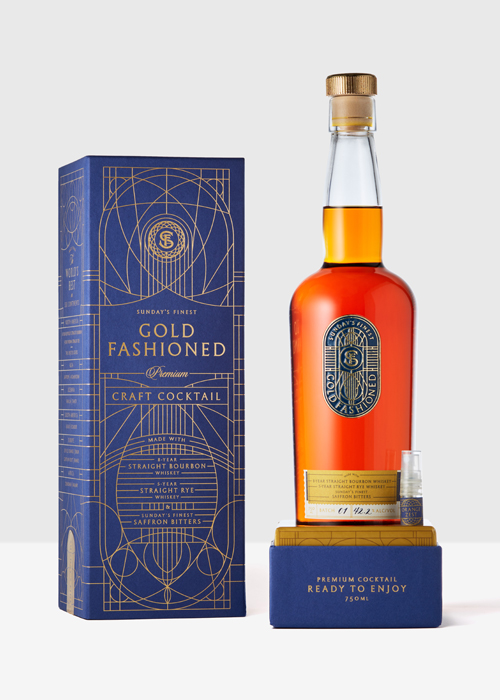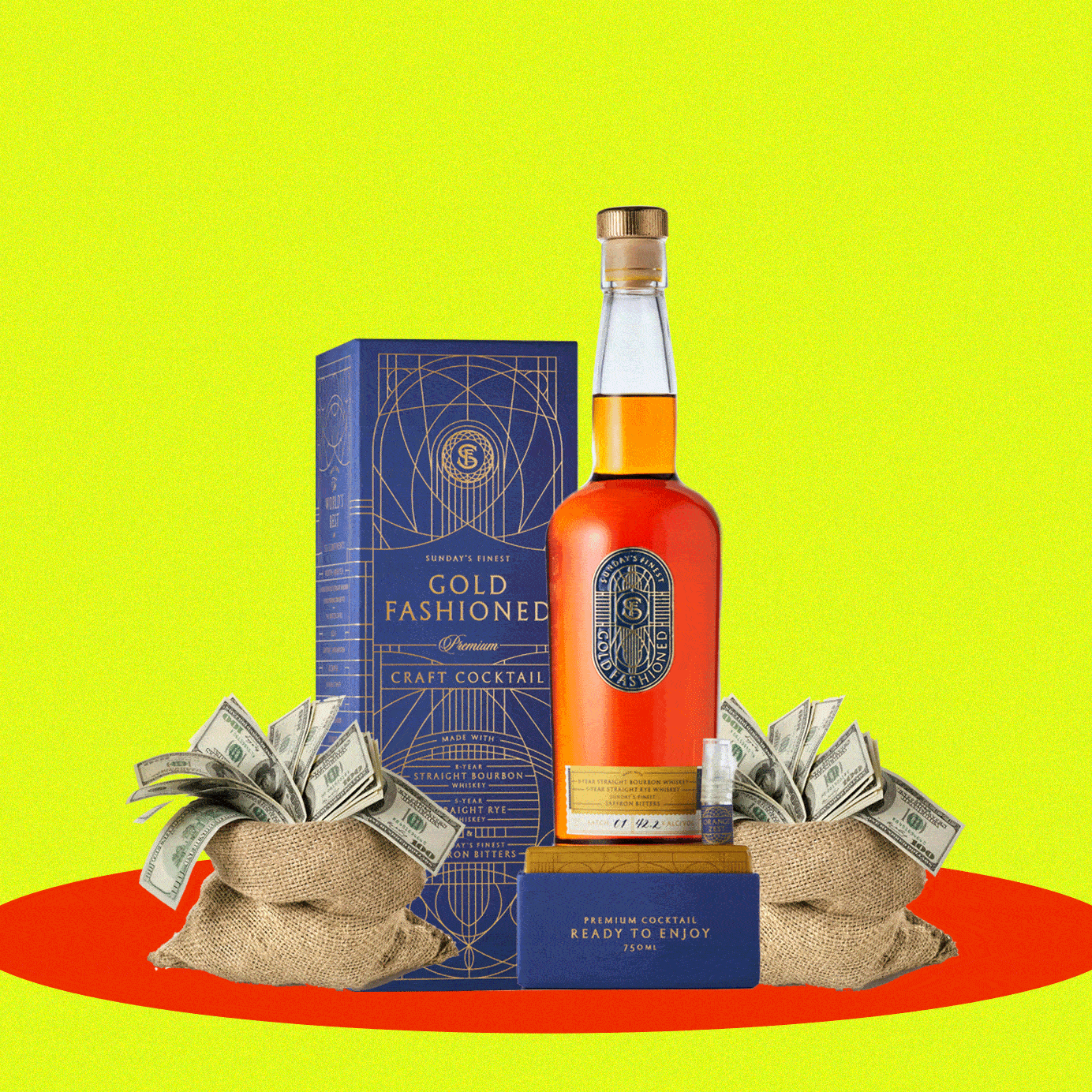All September on VinePair, we’re turning our focus to America’s spirit: bourbon. For our third annual Bourbon Month, we’re exploring the industry legends and innovators, our favorite craft distilleries, new bottles we love, and more.
If there’s one hard and fast rule in the wonderful world of alcohol, it’s that once something becomes popular, luxury versions of it eventually emerge. That’s how bourbon went from a humble working man’s drink to $2,000 releases in a crystal decanter. It’s how we ended up with $3.5 million bottles of tequila and 80-year-old single malt packaged in boxes designed by a knighted architect. It’s why we now have a $90 6-pack of beer.
And that’s now why, in this era of RTD (ready to drink) madness — where sales for the long-overlooked category began booming during Covid-19 lockdowns — you get the $150 Gold Fashioned, made from some of the world’s most expensive and lavish ingredients.
Brought to you by Robert Haynes, former beverage director for Chicago’s seminal the Violet Hour, in the past decade he created Leatherbee Bësk, a boutique version of Chicago’s infamous Malört, collaborated with Apologue Liqueurs, and during the pandemic began exploring the RTD space by helping to design the canned cocktails for Chicago’s Big Star.
“That was the real eye-opener for me,” says Haynes. “I saw a lot of opportunity in the ready-to-drink space — certainly room for elevation and improvement in the category.”
Haynes claims the Gold Fashioned is the culmination of all his experiences in the cocktail world: designing house-made bitters for Violet Hour, working with esoteric botanicals and unique ingredients for Apologue, and continually trying to improve on the classics via rote repetition.
“People talk about [Malcolm Gladwell’s] 10,000 hours rule, and I think the same thing happens with cocktails,” says Haynes. “If you make 10,000 Old Fashioneds, you start to connect to the drink more than just executing the recipe.”
Of course, it’s not exactly easy to elevate the world’s simplest cocktail, though bartenders have tried for years, using rare bourbons, fat-washing with bacon like in the case of PDT’s iconic Benton’s Old Fashioned, and/or injecting tons of pizzazz, like serving the drink “In the Rocks” as The Aviary does with its Old Fashioned of that name, which is literally injected into a hollow ice ball that must be shattered with a tiny slingshot in order to consume.
(Even Haynes has toyed with reinventing the Old Fashioned before, creating a tequila shot-like serving of it for his short-lived Analogue bar, in which customers would lick Demerara sugar off their hands, take a shot of whiskey with Angostura bitters in it, and then bite an orange wedge. This never quite took off, but I kinda think it should have!)

“We wanted to use the world’s most exquisite spices sourced from the country of origin, and use them to accentuate the flavors and aromas already happening in the whiskey,” says Haynes. “And to me, bitters still feel magical, alchemical.”
For his bitters blend, Haynes starts with saffron hand-picked in Herat, Afghanistan. Famously the world’s most expensive spice, it goes for around $2,700 a pound at the moment. It’s a spice he has long wanted to explore the true potential of a bit more, ever since he made a saffron liqueur for Apologue.
“For all the other ingredients, we just went for the gold standards,” says Haynes.
Seville orange peel from Spain.
Single-origin Ecuadorian cacao.
Grade A Tahitian vanilla bean. (“As fat as your finger and so juicy.”)
Wild-harvested gentian root from the French Alps.
He hadn’t meant to, but Haynes had inadvertently sourced ingredients from all six of the inhabited continents on earth. (Unfortunately, Haynes couldn’t figure out a way to include, say, a freshly carved block of Antarctic ice, so you’ll have to source that one yourself.)
“Early on at Violet Hour, my mentor Toby Maloney turned me onto the idea that a cocktail can tell a story, in like a real way,” says Haynes. “It can have a narrative both in how it tastes and in how you experience it. If it’s conceptually sound, that will carry on to all the choices made throughout it, and that will include the ingredients. I wanted the Gold Fashioned to feel truly extraordinary.”
Of course, you have to really wonder, is this truly extraordinary or is it just a silly gimmick? Is Malawian Demerara syrup that much better than what I could make using Brooklyn sugar?
“I do find that pure Demerara gives a mouthfeel that is more rich and luxurious than granulated sugar,” he says. “But I mainly wanted it to be worldly.”
The most important ingredient, of course, is probably where I see the most criticism coming toward the Gold Fashioned, especially from the always-hating “taters” that frequent online whiskey discussion. Haynes uses a split base of sourced, barrel-strength 8-year-old bourbon from a major Kentucky distillery he keeps undisclosed, as well as 5-year-old rye from MGP in Indiana.
“I do think in cocktails there’s a point of diminishing returns with age,” says Haynes, in defending the choices. He thinks nuance is lost when too mature whiskey is used in the Old Fashioned, feeling the sweet spot for the cocktail is around the ages he sourced. “We also wanted something that would hold up to the bitters. For this cocktail I was always thinking flavor first.”
Of course, all luxury alcohol products need to be lavishly packaged (“taken over the top,” says Haynes) and indeed the Gold Fashioned is, coming in a “presentation box” decorated with gold embossed Art Deco design and lettering. It even includes an atomizer filled with orange zest and meant to be spritzed on the surface of the cocktail, which, presumably, you will have just poured into chilled glassware using the included pour spout.
But, any time I write these sorts of articles, the one thing people really want to know: Is it worth all that scratch?
It’s expensive, sure, but not alarmingly so if you really price it out. It’s pretty high proof at 42.2 percent ABV and a 750- milliliter bottle measures out to around 10 to 12 servings, which gives you a $12 to $15 cocktail — spendy for at-home, sure, but standard bar prices. Haynes thinks it’s perfect for group celebrations.
“If someone breaks it out at dinner, no one is going to forget that moment,” says Haynes.
Or could it become the world’s first collectible RTD?
Only around 9,000 bottles were produced, mostly available online via ReserveBar, and this may end up being the sole Gold Fashioned ever. World supply chains are currently stressed, the Taliban has taken over Afghanistan, and, oddly, well-aged American whiskey might be harder to source than any rare botanical these days. That’s why Haynes is looking toward other stirred, spirituous cocktails for future gold-standard RTDs.
Could the Gold Martini be next? Haynes thinks it’s certainly possible.
“I heard this term once and I use it often, but I don’t know if it’s a real word: ‘organoleptic.’ It means it’s engaging all the senses,” he says. “To me it feels like I’ve created this intersection between consumer packaged goods and art.”
This story is a part of VP Pro, our free platform and newsletter for drinks industry professionals, covering wine, beer, liquor, and beyond. Sign up for VP Pro now!
